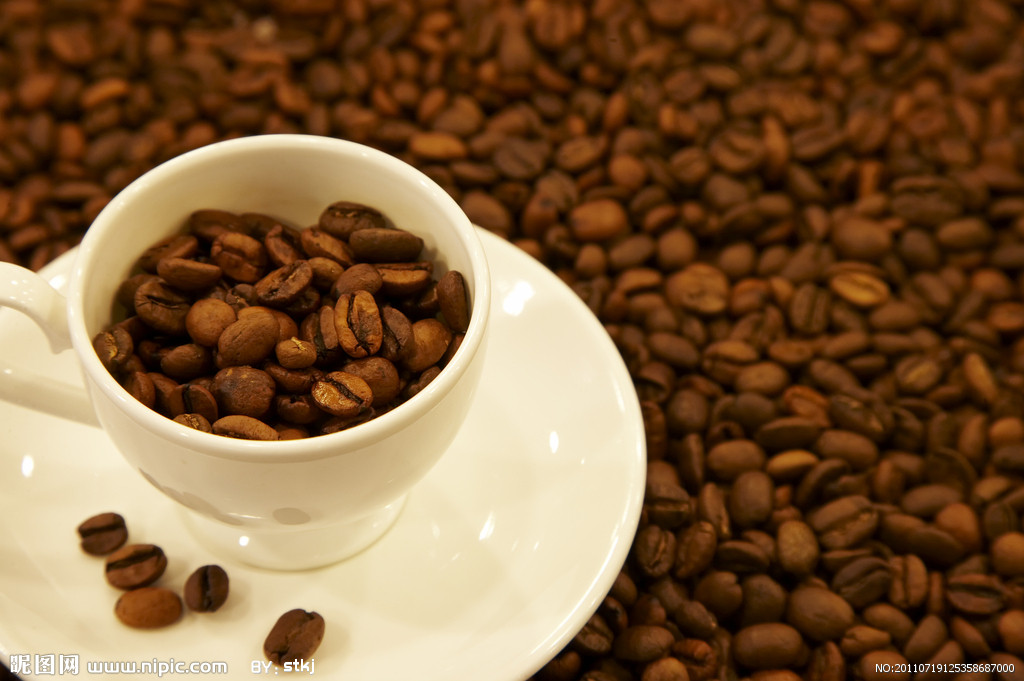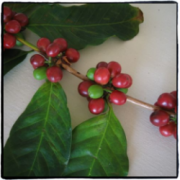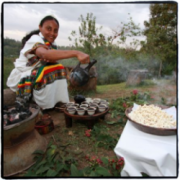The most critical 45 seconds of coffee life

On June 18, people passing by the exhibition hall of the International Trade Center will smell a strong coffee smell. If you follow the aroma, through the doors of the exhibition hall, you will find a world of coffee.
The huge machine was like a small locomotive, with a large round basin attached to the front end. In the round basin, several spiral arms were completely submerged in the coffee beans with a yellowish metallic luster. The coffee beans are stirred like a turbine, and wherever the spiral arm touches, it rolls like a wave. This is the first day of Beijing International Coffee Expo. Visitors gathered around the basin, picking up a freshly roasted coffee bean from time to time and stuffing it into their mouths.
Enthusiasts love complicated appliances
A middle-aged man walked past a stand selling filtered coffee cups, and the woman at the stand just opened her mouth to introduce it. The man smiled and replied,"This is too easy for me." My degree, at least, is siphoning."
What men call "siphon" is a complicated coffee pot. It usually has two layers. Add hot water to the bottom pot and coffee powder to the top pot. Under the heating of alcohol lamp and induction cooker, the water in the lower pot will slowly boil and climb up little by little until it rises into the upper pot. After the coffee powder in the upper pot has been fully extracted by boiling water, turn off the heat source, and the coffee will flow into the lower pot, accompanied by a large amount of light brown foam, which is the coffee fat and the essence of a cup of coffee.
In the eyes of "ashes" coffee lovers,"siphon pot" is their ultimate appliance. The improved "siphon pot" also allows the extracted coffee to flow into the cup and coffee pot through small tubes.
The most important 45 seconds of coffee life
At the intersection of Lize Road in Beijing and South Square Road of West Railway Station, there is a workshop that is not very eye-catching in appearance. The owner is called "Uncle Bean" and is a member of the European Fine Coffee Association. When he saw "Uncle Bean", he was in front of a big "stove" and told 20 fans about the origin of coffee. This large "stove" is a high-end roaster that is highly regarded by professionals, and many roasters dream of one day operating it to express their coffee ideals. "Uncle Bean" held up a large photo taken from his plantation in Kenya, explaining how the locals picked and sifted coffee cherries, how to dry or wash them to remove the flesh of the "cherry", remove the parchment-like shell of the "cherry core", and stick to the pectin on the shell; until the gray-green kernel was removed from the core, it was coffee beans.
A bucket of green coffee beans is poured into a large preheated "stove" and a switch is activated. About ten minutes later, there was a crackling sound in the furnace. This was the first crack of the coffee beans. Before that, they had been undergoing physical changes in the furnace.
The 45 seconds after the explosion is the most critical moment in the life of the coffee bean. During this time, a series of physical and chemical changes will occur in these beans. They continue to dehydrate and swell, their sugar content turning to caramel and carbon dioxide at high temperatures, their greyish green bodies turning brown and full and shiny; their substances eventually turn into caramel, flavor oils, quinic acid, caffeine. The flavor oil is a "fragrance family" with more than 800 members.
The composition and content of these aromatic substances vary greatly according to the different regions of raw beans, picking methods, peeling methods, baking temperature and baking time. So far, no one knows exactly what happened to the beans in such a short 45 seconds.
Uncle Bean opened the floodgates before the beans exploded a second time and entered deep roasting. A burnt aroma instantly rose, and the coffee beans poured into the large plate at the front of the stove like a flood. Driven by the rotating arm, they quickly cooled down.
Making good coffee is only one step more than instant coffee.
In China, people's understanding of coffee, if not stay at the "instant" level, is to know the coffee culture everywhere, to collect expensive coffee beans, fancy and expensive appliances.
Blue Mountain of Jamaica, Kona of Hawaii, Harald of Ethiopia, Premium of Colombia, Golden Mandelin of Sumatra... are some of the world's top coffee beans. Wei Lingpeng, director of Coffee Salon, said good beans are the basis for making a good cup of coffee. However, to make a cup of coffee that suits you and find the beans you like is the beginning of the "road to exploration."
However,"Uncle Bean" makes coffee appliances, just a 49 yuan French press pot. He makes a cup of coffee simply one step more than instant.
He poured a portion of coffee powder into the pot and added 92 ° C water. If you turn off the heat, open the lid, and cool the boiling water for 1 minute, the water temperature will be almost 92℃. This is the temperature at which coffee brings out its best flavor. Uncle Bean poured water into the pot and left it for 1 minute. Then he gently pressed the end of the pot between the golden oil and the water. After 1 minute, slowly press the finale to the bottom. Coffee poured into the cup, a strong smell of nuts overflow.
The charm of coffee lies in its variety. There are the most expensive coffee beans in the world, but there is no best coffee. More than 800 aromatic compounds can vary according to one's preferences. When attention is focused on the nose and mouth, the taste buds of the tongue will tell us that every sip of coffee contains aroma, flavor, alcohol, acidity, sweetness and aftertaste. Different coffee, fruit, nuts, caramel and other flavors. Everyone can always find their own coffee. Europeans don't like "instant." But they also do not like cumbersome, willing to bake, grinding things to businessmen, the processing process as much as possible simplified, leave the taste of time to themselves.
When the complexity becomes simple, the Chinese will really fall in love with coffee and truly enjoy it.
China Coffee Trading Network: www.gafei.com
Important Notice :
前街咖啡 FrontStreet Coffee has moved to new addredd:
FrontStreet Coffee Address: 315,Donghua East Road,GuangZhou
Tel:020 38364473
- Prev

Introduction to Hawaiian boutique coffee
Hawaii is a good place. Hawaiian coffee is more expensive. It is characterized by moderation. Not all Hawaiian coffee is good coffee, only a few coffee has the possibility of becoming boutique coffee.
- Next

Introduction to Ethiopian boutique coffee
Saifeng is one of the highest quality coffee producers in the world. The unique geographical environment, a wide variety of coffee varieties and the tradition of wet processing make Ethiopian coffee bring us bright and vivid taste and rich fruit and flower aromas.
Related
- Beginners will see the "Coffee pull flower" guide!
- What is the difference between ice blog purified milk and ordinary milk coffee?
- Why is the Philippines the largest producer of crops in Liberia?
- For coffee extraction, should the fine powder be retained?
- How does extracted espresso fill pressed powder? How much strength does it take to press the powder?
- How to make jasmine cold extract coffee? Is the jasmine + latte good?
- Will this little toy really make the coffee taste better? How does Lily Drip affect coffee extraction?
- Will the action of slapping the filter cup also affect coffee extraction?
- What's the difference between powder-to-water ratio and powder-to-liquid ratio?
- What is the Ethiopian local species? What does it have to do with Heirloom native species?

